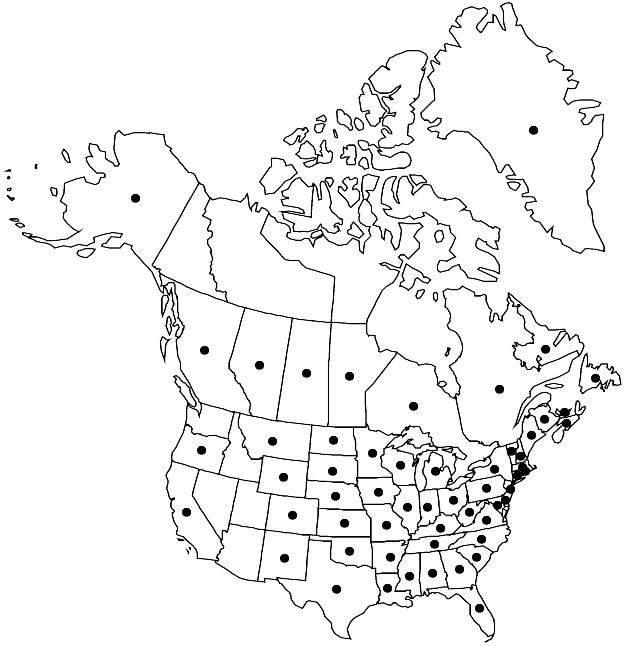Plagiomnium cuspidatum
Ann. Bot. Fenn. 5: 146. 1968.
Erect stems 1–2(–3.5) cm, not dendroid; sterile stems to 7 cm. Leaves dark green or yellow-green, contorted when dry, flat when moist, obovate, ± diamond-shaped or occasionally elliptic, 3–5 mm; base broadly long-decurrent; margins toothed from about mid leaf to apex, teeth sharp, of 1 (or 2) cells; apex acute or acuminate, long-cuspidate, cusp sometimes toothed; costa percurrent or excurrent; medial laminal cells short-elongate or ± isodiametric, 20–30(–40) µm, slightly smaller near margins, occasionally in longitudinal rows, rarely in diagonal rows, strongly collenchymatous, walls not pitted; marginal cells linear, in 2–4(–5) rows. Sexual condition synoicous. Seta single, yellow, brown, or sometimes reddish, 2–3 cm. Capsule pendent, ovoid or cylindric, 2–3.5 mm, neck not distinct; operculum conic-apiculate. Spores 18–31 µm.
Phenology: Capsules mature late spring.
Habitat: Soil, logs, rock, stumps or tree bases in wet meadows/carrs, forested rich peatlands, wet forests, fire-dependent forests/woodlands, mesic hardwood forests, cliff/talus
Elevation: low to moderate elevations
Distribution

Greenland, Alta., B.C., Man., N.B., Nfld. and Labr., N.S., Ont., P.E.I., Que., Sask., Ala., Alaska, Ark., Calif., Colo., Conn., Del., Fla., Ga., Ill., Ind., Iowa, Kans., Ky., La., Maine, Md., Mass., Mich., Minn., Miss., Mo., Mont., Nebr., N.H., N.J., N.Mex., N.Y., N.C., N.Dak., Ohio, Okla., Oreg., Pa., R.I., S.C., S.Dak., Tenn., Tex., Vt., Va., W.Va., Wis., Wyo., Mexico (México), Europe, Asia, Africa.
Discussion
Plagiomnium cuspidatum, P. drummondii, and P. floridanum are the only North American species of the genus that consistently have well-developed, sharp teeth restricted to the distal portions of the leaf margins. Plagiomnium ellipticum and P. rostratum often have leaves that are toothed only distally, but the teeth are small and mostly blunt, and the leaves are never obovate. Plagiomnium cuspidatum has larger leaves and larger, less collenchymatous laminal cells than P. drummondii and P. floridanum. The thinner cell walls and larger cells of P. drummondii give it a distinctly more translucent aspect than P. cuspidatum and P. floridanum.
In addition to the morphological characters in the key, Plagiomnium cuspidatum is separated from the closely allied P. floridanum by sexual condition, ploidy level, and ecology (R. Wyatt and I. J. Odrzykoski 2012). Plagiomnium cuspidatum is synoicous and diploid, with a chromosome count of n = 12, whereas P. floridanum is dioicous and haploid, with a chromosome count of n = 6. Although Plagiomnium cuspidatum exhibits a relatively broad ecological amplitude, P. floridanum shows a preference for soils associated with limestone.
Selected References
None.